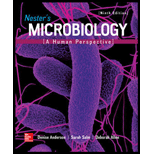
Nester's Microbiology: A Human Perspective
9th Edition
ISBN: 9781259709999
Author: Denise G. Anderson Lecturer, Sarah Salm, Deborah Allen
Publisher: McGraw-Hill Education
expand_more
expand_more
format_list_bulleted
Textbook Question
Chapter 2, Problem 1SA
Differentiate between an atom, a molecule, and a compound.
Expert Solution & Answer
Summary Introduction
To review:
The differences between an atom, a molecule, and a compound.
Introduction:
The entire matter present in the universe is composed up of small particles, which are referred to as an atom. About 92 different kinds of atoms are present in nature and all these unite together in order to form different kinds of matter, which can be seen in nature.
Explanation of Solution
| Atom | Molecule | Compound |
| An atom refers to a single nucleus and is surrounded by a minimum of one electron. They are made of neutrons, electrons, and protons. | A molecule refers to the club of more than two or two atoms, which are bonded covalently together and form a structure. | Compound refers to the term, which means the combination of two or even more than two different kinds of atoms. Most of the molecules present in nature are regarded as compounds. It can be held by a covalent bond. In ionic compounds, ionic bonds are present. |
| For example, Gold comprises atoms with 79 protons. | For example, H2O (water) | For example, NaCl (table salt) |
Conclusion
Therefore, it can be concluded that an atom is the smallest unit of the matter, which makes up a molecule or a compound.
Want to see more full solutions like this?
Subscribe now to access step-by-step solutions to millions of textbook problems written by subject matter experts!
Students have asked these similar questions
Define and distinguish between matter, elements, and compounds.
Distinguish between atoms and elements.
List the Components of Atoms?
Chapter 2 Solutions
Nester's Microbiology: A Human Perspective
Ch. 2 - Differentiate between an atom, a molecule, and a...Ch. 2 -
2. Why is water a good solvent?
Ch. 2 - Which solution is more acidic, one with a pH of 4...Ch. 2 - Prob. 4SACh. 2 - Prob. 5SACh. 2 - What is a structural isomer?Ch. 2 - Name the major groups of lipids and give an...Ch. 2 - List six functions of proteins.Ch. 2 -
9. What are the four levels of protein structure,...Ch. 2 - How do DNA and RNA differ from one another in...
Ch. 2 - Choose the list that goes from the lightest to the...Ch. 2 -
2. An oxygen atom has an atomic number of 8. It...Ch. 2 - Dehydration synthesis is involved in the synthesis...Ch. 2 - The primary structure of a protein relates to its...Ch. 2 -
5. Pure water has all of the following properties...Ch. 2 - When the pH of a solution changes from 3 to 8, the...Ch. 2 - A shortage of nitrogen (N) would make it most...Ch. 2 - Complementarity plays a major role in the...Ch. 2 - Prob. 9MCCh. 2 - The function of a buffer is to a) bring the pH of...Ch. 2 - A group of prokaryotes known as thermophiles...Ch. 2 -
2. Microorganisms use hydrogen bonds to attach to...Ch. 2 - What properties of the carbon atom make it ideal...Ch. 2 -
2. A biologist determined the amounts of several...Ch. 2 - The table on the right indicates the freezing and...
Knowledge Booster
Learn more about
Need a deep-dive on the concept behind this application? Look no further. Learn more about this topic, biology and related others by exploring similar questions and additional content below.Similar questions
arrow_back_ios
arrow_forward_ios
Recommended textbooks for you
 Principles Of Radiographic Imaging: An Art And A ...Health & NutritionISBN:9781337711067Author:Richard R. Carlton, Arlene M. Adler, Vesna BalacPublisher:Cengage Learning
Principles Of Radiographic Imaging: An Art And A ...Health & NutritionISBN:9781337711067Author:Richard R. Carlton, Arlene M. Adler, Vesna BalacPublisher:Cengage Learning Human Biology (MindTap Course List)BiologyISBN:9781305112100Author:Cecie Starr, Beverly McMillanPublisher:Cengage Learning
Human Biology (MindTap Course List)BiologyISBN:9781305112100Author:Cecie Starr, Beverly McMillanPublisher:Cengage Learning Biology (MindTap Course List)BiologyISBN:9781337392938Author:Eldra Solomon, Charles Martin, Diana W. Martin, Linda R. BergPublisher:Cengage Learning
Biology (MindTap Course List)BiologyISBN:9781337392938Author:Eldra Solomon, Charles Martin, Diana W. Martin, Linda R. BergPublisher:Cengage Learning Biology: The Dynamic Science (MindTap Course List)BiologyISBN:9781305389892Author:Peter J. Russell, Paul E. Hertz, Beverly McMillanPublisher:Cengage Learning
Biology: The Dynamic Science (MindTap Course List)BiologyISBN:9781305389892Author:Peter J. Russell, Paul E. Hertz, Beverly McMillanPublisher:Cengage Learning

Principles Of Radiographic Imaging: An Art And A ...
Health & Nutrition
ISBN:9781337711067
Author:Richard R. Carlton, Arlene M. Adler, Vesna Balac
Publisher:Cengage Learning


Human Biology (MindTap Course List)
Biology
ISBN:9781305112100
Author:Cecie Starr, Beverly McMillan
Publisher:Cengage Learning


Biology (MindTap Course List)
Biology
ISBN:9781337392938
Author:Eldra Solomon, Charles Martin, Diana W. Martin, Linda R. Berg
Publisher:Cengage Learning

Biology: The Dynamic Science (MindTap Course List)
Biology
ISBN:9781305389892
Author:Peter J. Russell, Paul E. Hertz, Beverly McMillan
Publisher:Cengage Learning
GCSE Chemistry - Acids and Bases #34; Author: Cognito;https://www.youtube.com/watch?v=vt8fB3MFzLk;License: Standard youtube license